Report: Examining Mental Health as a Key Youth Issue in Australia
VerifiedAdded on 2023/01/12
|18
|5353
|57
Report
AI Summary
This report delves into various youth issues, with a primary focus on mental health challenges in Australia. It examines the prevalence of mental health concerns among teenagers, supported by media reports and statistical data. The report analyzes how media portrays these issues, identifying stereotypes and specific language used to describe mental health problems. It explores the role of social media, societal pressures, and infrastructure limitations in contributing to youth mental health issues. Roizen’s 4L’s Model is mentioned in the context of substance abuse, another critical youth issue. The report highlights the urgent need for support and education during the transition phase to adulthood, emphasizing the importance of addressing issues like substance abuse, risky behaviors, and mental health to ensure a positive transition for young individuals. Desklib offers a range of resources for students to further explore these topics, including past papers and solved assignments.
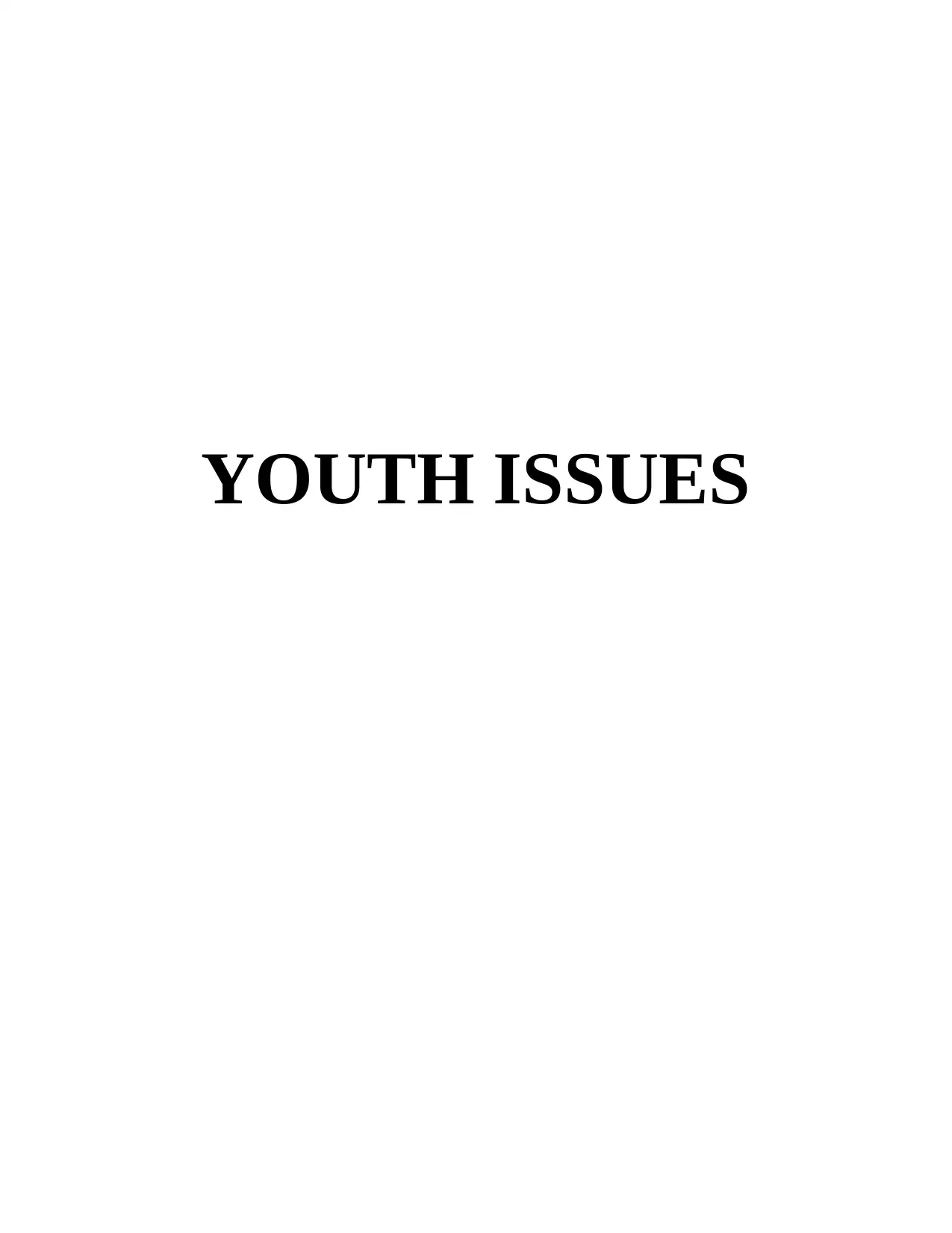
YOUTH ISSUES
Paraphrase This Document
Need a fresh take? Get an instant paraphrase of this document with our AI Paraphraser
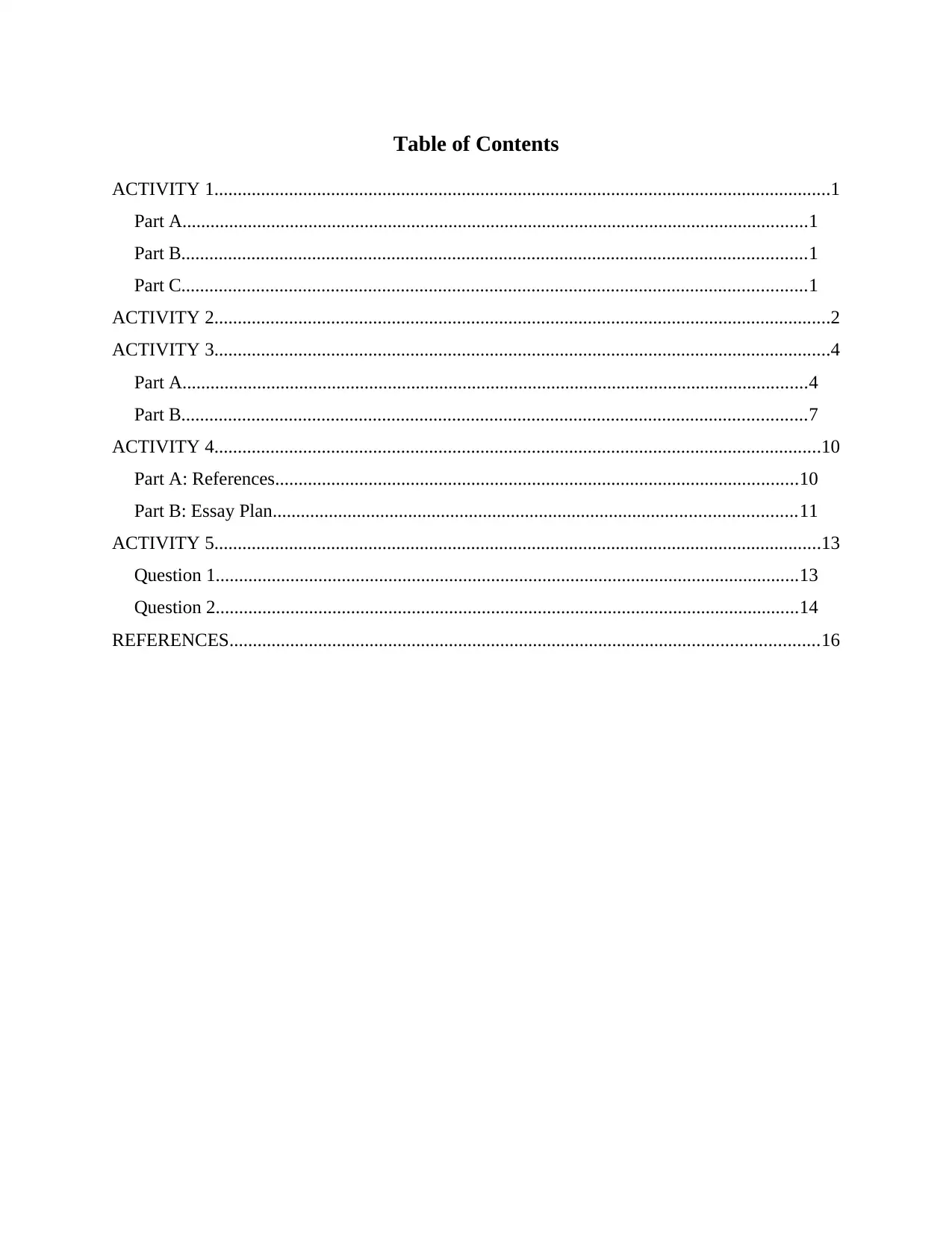
Table of Contents
ACTIVITY 1....................................................................................................................................1
Part A......................................................................................................................................1
Part B......................................................................................................................................1
Part C......................................................................................................................................1
ACTIVITY 2....................................................................................................................................2
ACTIVITY 3....................................................................................................................................4
Part A......................................................................................................................................4
Part B......................................................................................................................................7
ACTIVITY 4..................................................................................................................................10
Part A: References................................................................................................................10
Part B: Essay Plan................................................................................................................11
ACTIVITY 5..................................................................................................................................13
Question 1.............................................................................................................................13
Question 2.............................................................................................................................14
REFERENCES..............................................................................................................................16
ACTIVITY 1....................................................................................................................................1
Part A......................................................................................................................................1
Part B......................................................................................................................................1
Part C......................................................................................................................................1
ACTIVITY 2....................................................................................................................................2
ACTIVITY 3....................................................................................................................................4
Part A......................................................................................................................................4
Part B......................................................................................................................................7
ACTIVITY 4..................................................................................................................................10
Part A: References................................................................................................................10
Part B: Essay Plan................................................................................................................11
ACTIVITY 5..................................................................................................................................13
Question 1.............................................................................................................................13
Question 2.............................................................................................................................14
REFERENCES..............................................................................................................................16
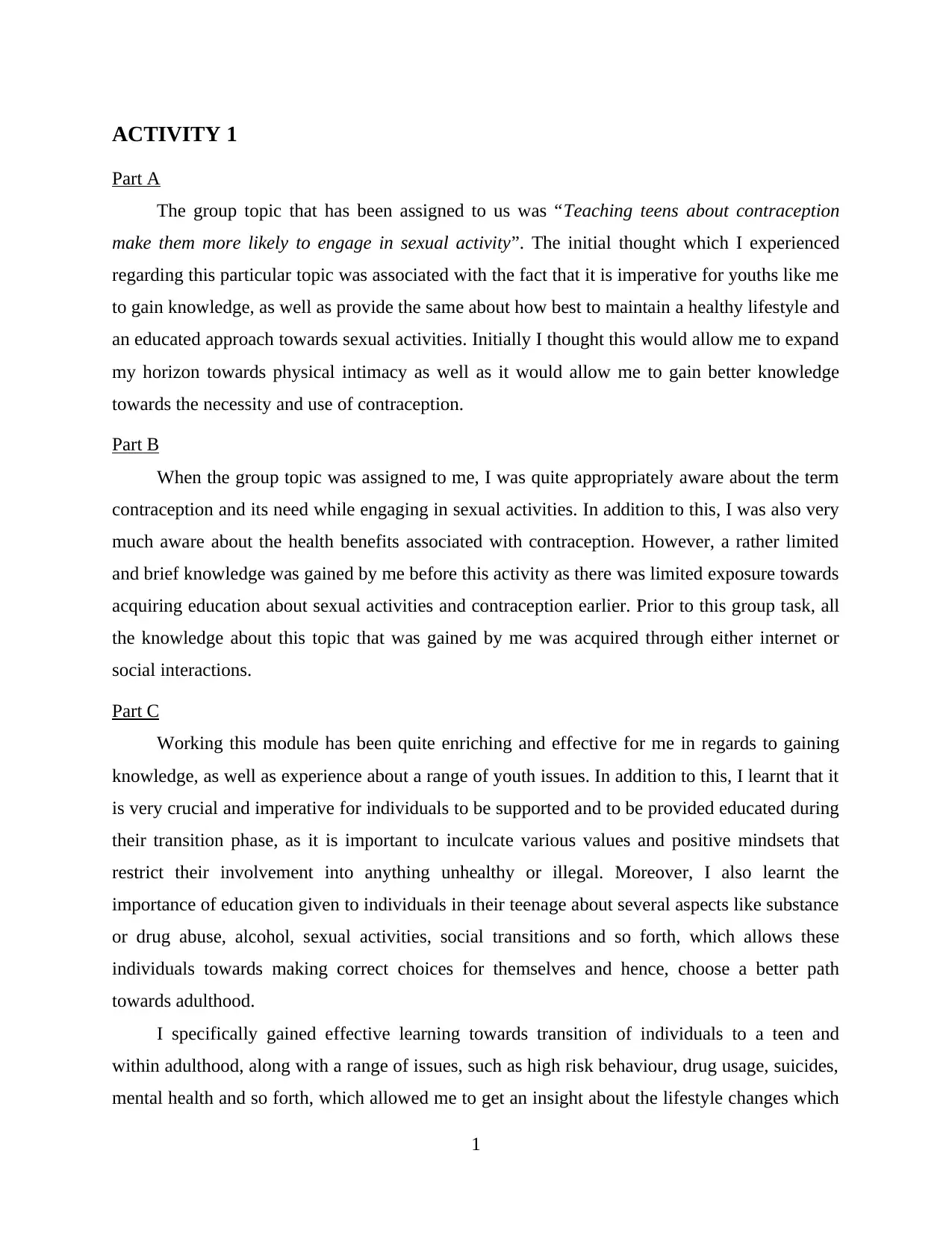
ACTIVITY 1
Part A
The group topic that has been assigned to us was “Teaching teens about contraception
make them more likely to engage in sexual activity”. The initial thought which I experienced
regarding this particular topic was associated with the fact that it is imperative for youths like me
to gain knowledge, as well as provide the same about how best to maintain a healthy lifestyle and
an educated approach towards sexual activities. Initially I thought this would allow me to expand
my horizon towards physical intimacy as well as it would allow me to gain better knowledge
towards the necessity and use of contraception.
Part B
When the group topic was assigned to me, I was quite appropriately aware about the term
contraception and its need while engaging in sexual activities. In addition to this, I was also very
much aware about the health benefits associated with contraception. However, a rather limited
and brief knowledge was gained by me before this activity as there was limited exposure towards
acquiring education about sexual activities and contraception earlier. Prior to this group task, all
the knowledge about this topic that was gained by me was acquired through either internet or
social interactions.
Part C
Working this module has been quite enriching and effective for me in regards to gaining
knowledge, as well as experience about a range of youth issues. In addition to this, I learnt that it
is very crucial and imperative for individuals to be supported and to be provided educated during
their transition phase, as it is important to inculcate various values and positive mindsets that
restrict their involvement into anything unhealthy or illegal. Moreover, I also learnt the
importance of education given to individuals in their teenage about several aspects like substance
or drug abuse, alcohol, sexual activities, social transitions and so forth, which allows these
individuals towards making correct choices for themselves and hence, choose a better path
towards adulthood.
I specifically gained effective learning towards transition of individuals to a teen and
within adulthood, along with a range of issues, such as high risk behaviour, drug usage, suicides,
mental health and so forth, which allowed me to get an insight about the lifestyle changes which
1
Part A
The group topic that has been assigned to us was “Teaching teens about contraception
make them more likely to engage in sexual activity”. The initial thought which I experienced
regarding this particular topic was associated with the fact that it is imperative for youths like me
to gain knowledge, as well as provide the same about how best to maintain a healthy lifestyle and
an educated approach towards sexual activities. Initially I thought this would allow me to expand
my horizon towards physical intimacy as well as it would allow me to gain better knowledge
towards the necessity and use of contraception.
Part B
When the group topic was assigned to me, I was quite appropriately aware about the term
contraception and its need while engaging in sexual activities. In addition to this, I was also very
much aware about the health benefits associated with contraception. However, a rather limited
and brief knowledge was gained by me before this activity as there was limited exposure towards
acquiring education about sexual activities and contraception earlier. Prior to this group task, all
the knowledge about this topic that was gained by me was acquired through either internet or
social interactions.
Part C
Working this module has been quite enriching and effective for me in regards to gaining
knowledge, as well as experience about a range of youth issues. In addition to this, I learnt that it
is very crucial and imperative for individuals to be supported and to be provided educated during
their transition phase, as it is important to inculcate various values and positive mindsets that
restrict their involvement into anything unhealthy or illegal. Moreover, I also learnt the
importance of education given to individuals in their teenage about several aspects like substance
or drug abuse, alcohol, sexual activities, social transitions and so forth, which allows these
individuals towards making correct choices for themselves and hence, choose a better path
towards adulthood.
I specifically gained effective learning towards transition of individuals to a teen and
within adulthood, along with a range of issues, such as high risk behaviour, drug usage, suicides,
mental health and so forth, which allowed me to get an insight about the lifestyle changes which
1
⊘ This is a preview!⊘
Do you want full access?
Subscribe today to unlock all pages.

Trusted by 1+ million students worldwide
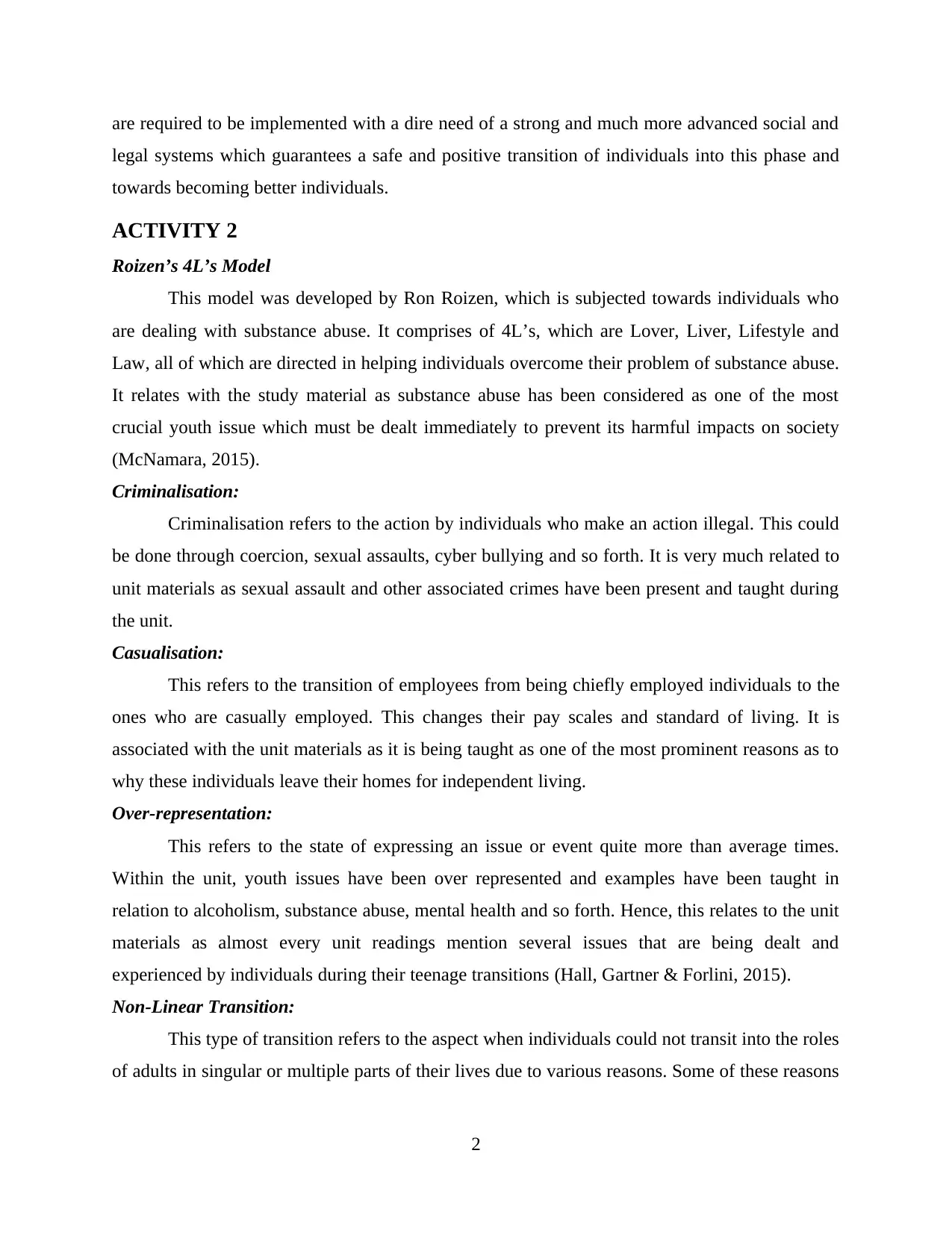
are required to be implemented with a dire need of a strong and much more advanced social and
legal systems which guarantees a safe and positive transition of individuals into this phase and
towards becoming better individuals.
ACTIVITY 2
Roizen’s 4L’s Model
This model was developed by Ron Roizen, which is subjected towards individuals who
are dealing with substance abuse. It comprises of 4L’s, which are Lover, Liver, Lifestyle and
Law, all of which are directed in helping individuals overcome their problem of substance abuse.
It relates with the study material as substance abuse has been considered as one of the most
crucial youth issue which must be dealt immediately to prevent its harmful impacts on society
(McNamara, 2015).
Criminalisation:
Criminalisation refers to the action by individuals who make an action illegal. This could
be done through coercion, sexual assaults, cyber bullying and so forth. It is very much related to
unit materials as sexual assault and other associated crimes have been present and taught during
the unit.
Casualisation:
This refers to the transition of employees from being chiefly employed individuals to the
ones who are casually employed. This changes their pay scales and standard of living. It is
associated with the unit materials as it is being taught as one of the most prominent reasons as to
why these individuals leave their homes for independent living.
Over-representation:
This refers to the state of expressing an issue or event quite more than average times.
Within the unit, youth issues have been over represented and examples have been taught in
relation to alcoholism, substance abuse, mental health and so forth. Hence, this relates to the unit
materials as almost every unit readings mention several issues that are being dealt and
experienced by individuals during their teenage transitions (Hall, Gartner & Forlini, 2015).
Non-Linear Transition:
This type of transition refers to the aspect when individuals could not transit into the roles
of adults in singular or multiple parts of their lives due to various reasons. Some of these reasons
2
legal systems which guarantees a safe and positive transition of individuals into this phase and
towards becoming better individuals.
ACTIVITY 2
Roizen’s 4L’s Model
This model was developed by Ron Roizen, which is subjected towards individuals who
are dealing with substance abuse. It comprises of 4L’s, which are Lover, Liver, Lifestyle and
Law, all of which are directed in helping individuals overcome their problem of substance abuse.
It relates with the study material as substance abuse has been considered as one of the most
crucial youth issue which must be dealt immediately to prevent its harmful impacts on society
(McNamara, 2015).
Criminalisation:
Criminalisation refers to the action by individuals who make an action illegal. This could
be done through coercion, sexual assaults, cyber bullying and so forth. It is very much related to
unit materials as sexual assault and other associated crimes have been present and taught during
the unit.
Casualisation:
This refers to the transition of employees from being chiefly employed individuals to the
ones who are casually employed. This changes their pay scales and standard of living. It is
associated with the unit materials as it is being taught as one of the most prominent reasons as to
why these individuals leave their homes for independent living.
Over-representation:
This refers to the state of expressing an issue or event quite more than average times.
Within the unit, youth issues have been over represented and examples have been taught in
relation to alcoholism, substance abuse, mental health and so forth. Hence, this relates to the unit
materials as almost every unit readings mention several issues that are being dealt and
experienced by individuals during their teenage transitions (Hall, Gartner & Forlini, 2015).
Non-Linear Transition:
This type of transition refers to the aspect when individuals could not transit into the roles
of adults in singular or multiple parts of their lives due to various reasons. Some of these reasons
2
Paraphrase This Document
Need a fresh take? Get an instant paraphrase of this document with our AI Paraphraser
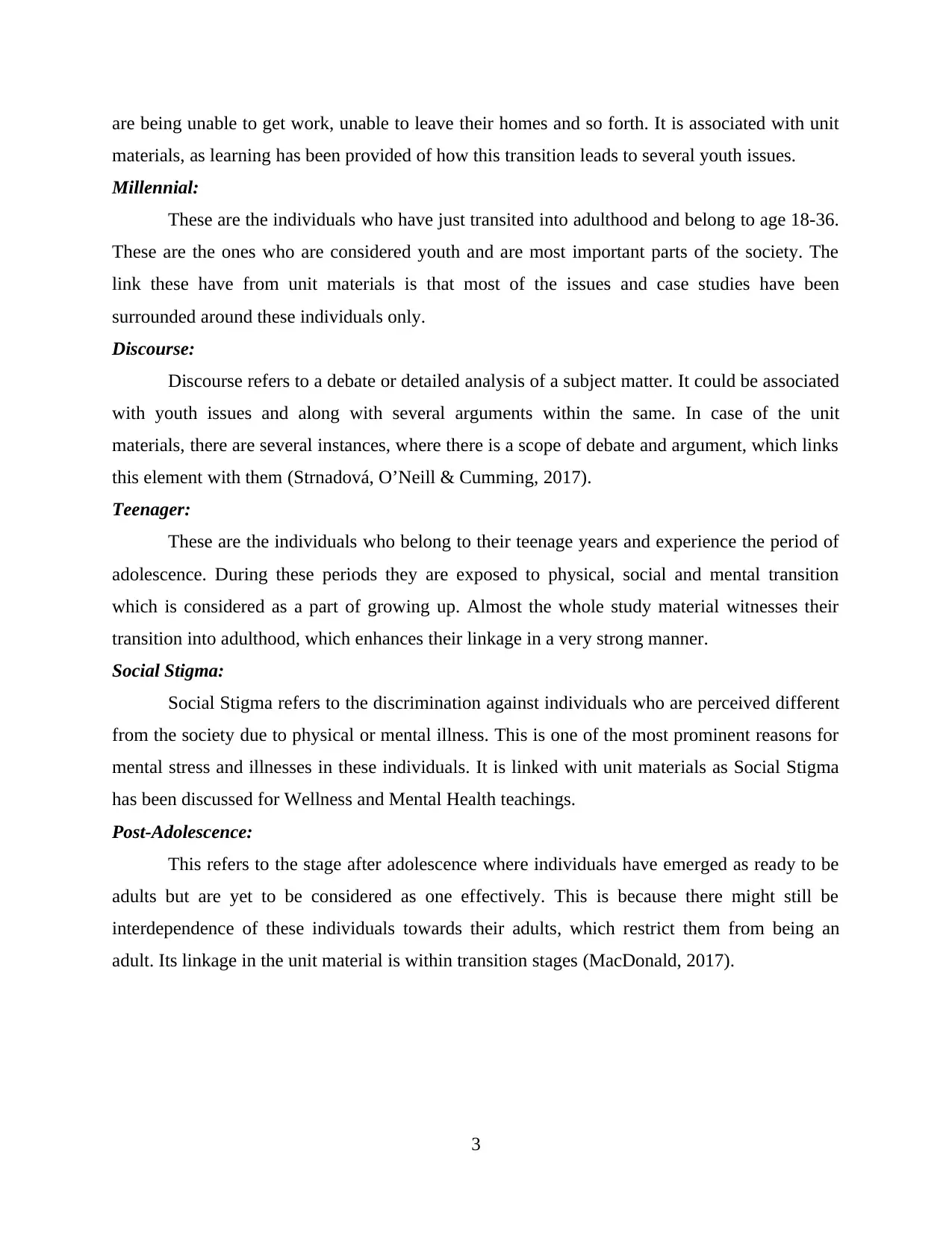
are being unable to get work, unable to leave their homes and so forth. It is associated with unit
materials, as learning has been provided of how this transition leads to several youth issues.
Millennial:
These are the individuals who have just transited into adulthood and belong to age 18-36.
These are the ones who are considered youth and are most important parts of the society. The
link these have from unit materials is that most of the issues and case studies have been
surrounded around these individuals only.
Discourse:
Discourse refers to a debate or detailed analysis of a subject matter. It could be associated
with youth issues and along with several arguments within the same. In case of the unit
materials, there are several instances, where there is a scope of debate and argument, which links
this element with them (Strnadová, O’Neill & Cumming, 2017).
Teenager:
These are the individuals who belong to their teenage years and experience the period of
adolescence. During these periods they are exposed to physical, social and mental transition
which is considered as a part of growing up. Almost the whole study material witnesses their
transition into adulthood, which enhances their linkage in a very strong manner.
Social Stigma:
Social Stigma refers to the discrimination against individuals who are perceived different
from the society due to physical or mental illness. This is one of the most prominent reasons for
mental stress and illnesses in these individuals. It is linked with unit materials as Social Stigma
has been discussed for Wellness and Mental Health teachings.
Post-Adolescence:
This refers to the stage after adolescence where individuals have emerged as ready to be
adults but are yet to be considered as one effectively. This is because there might still be
interdependence of these individuals towards their adults, which restrict them from being an
adult. Its linkage in the unit material is within transition stages (MacDonald, 2017).
3
materials, as learning has been provided of how this transition leads to several youth issues.
Millennial:
These are the individuals who have just transited into adulthood and belong to age 18-36.
These are the ones who are considered youth and are most important parts of the society. The
link these have from unit materials is that most of the issues and case studies have been
surrounded around these individuals only.
Discourse:
Discourse refers to a debate or detailed analysis of a subject matter. It could be associated
with youth issues and along with several arguments within the same. In case of the unit
materials, there are several instances, where there is a scope of debate and argument, which links
this element with them (Strnadová, O’Neill & Cumming, 2017).
Teenager:
These are the individuals who belong to their teenage years and experience the period of
adolescence. During these periods they are exposed to physical, social and mental transition
which is considered as a part of growing up. Almost the whole study material witnesses their
transition into adulthood, which enhances their linkage in a very strong manner.
Social Stigma:
Social Stigma refers to the discrimination against individuals who are perceived different
from the society due to physical or mental illness. This is one of the most prominent reasons for
mental stress and illnesses in these individuals. It is linked with unit materials as Social Stigma
has been discussed for Wellness and Mental Health teachings.
Post-Adolescence:
This refers to the stage after adolescence where individuals have emerged as ready to be
adults but are yet to be considered as one effectively. This is because there might still be
interdependence of these individuals towards their adults, which restrict them from being an
adult. Its linkage in the unit material is within transition stages (MacDonald, 2017).
3
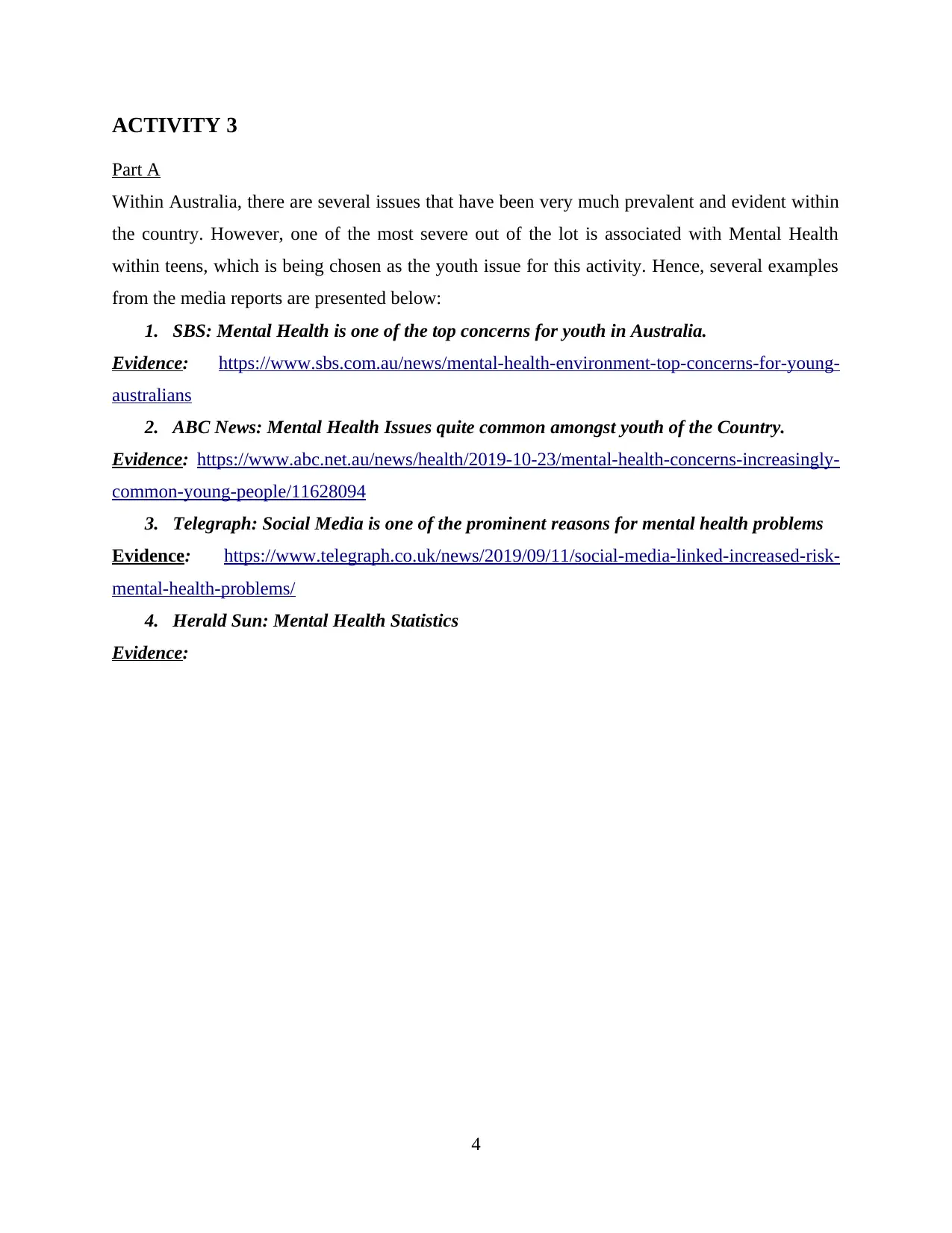
ACTIVITY 3
Part A
Within Australia, there are several issues that have been very much prevalent and evident within
the country. However, one of the most severe out of the lot is associated with Mental Health
within teens, which is being chosen as the youth issue for this activity. Hence, several examples
from the media reports are presented below:
1. SBS: Mental Health is one of the top concerns for youth in Australia.
Evidence: https://www.sbs.com.au/news/mental-health-environment-top-concerns-for-young-
australians
2. ABC News: Mental Health Issues quite common amongst youth of the Country.
Evidence: https://www.abc.net.au/news/health/2019-10-23/mental-health-concerns-increasingly-
common-young-people/11628094
3. Telegraph: Social Media is one of the prominent reasons for mental health problems
Evidence: https://www.telegraph.co.uk/news/2019/09/11/social-media-linked-increased-risk-
mental-health-problems/
4. Herald Sun: Mental Health Statistics
Evidence:
4
Part A
Within Australia, there are several issues that have been very much prevalent and evident within
the country. However, one of the most severe out of the lot is associated with Mental Health
within teens, which is being chosen as the youth issue for this activity. Hence, several examples
from the media reports are presented below:
1. SBS: Mental Health is one of the top concerns for youth in Australia.
Evidence: https://www.sbs.com.au/news/mental-health-environment-top-concerns-for-young-
australians
2. ABC News: Mental Health Issues quite common amongst youth of the Country.
Evidence: https://www.abc.net.au/news/health/2019-10-23/mental-health-concerns-increasingly-
common-young-people/11628094
3. Telegraph: Social Media is one of the prominent reasons for mental health problems
Evidence: https://www.telegraph.co.uk/news/2019/09/11/social-media-linked-increased-risk-
mental-health-problems/
4. Herald Sun: Mental Health Statistics
Evidence:
4
⊘ This is a preview!⊘
Do you want full access?
Subscribe today to unlock all pages.

Trusted by 1+ million students worldwide
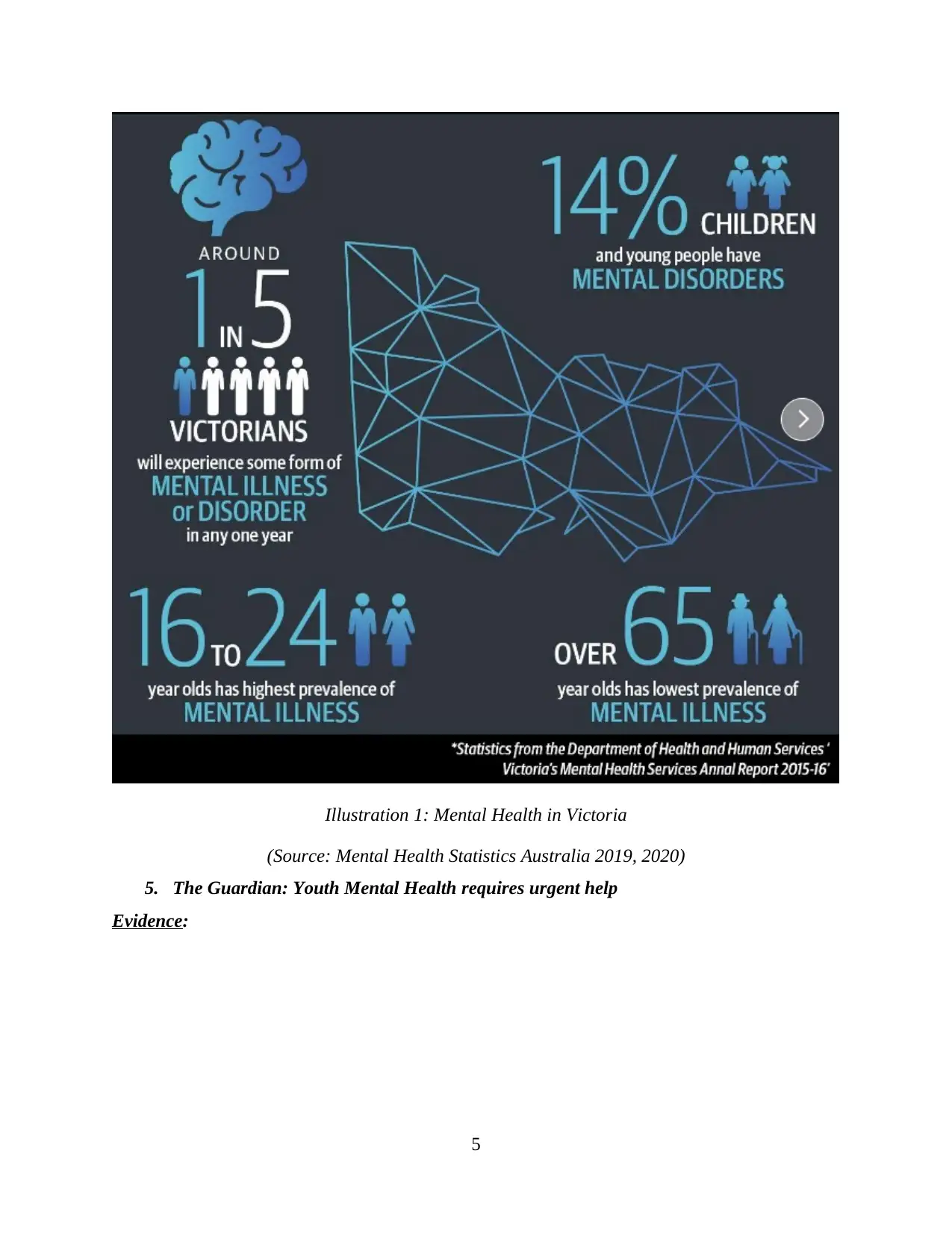
Illustration 1: Mental Health in Victoria
(Source: Mental Health Statistics Australia 2019, 2020)
5. The Guardian: Youth Mental Health requires urgent help
Evidence:
5
(Source: Mental Health Statistics Australia 2019, 2020)
5. The Guardian: Youth Mental Health requires urgent help
Evidence:
5
Paraphrase This Document
Need a fresh take? Get an instant paraphrase of this document with our AI Paraphraser
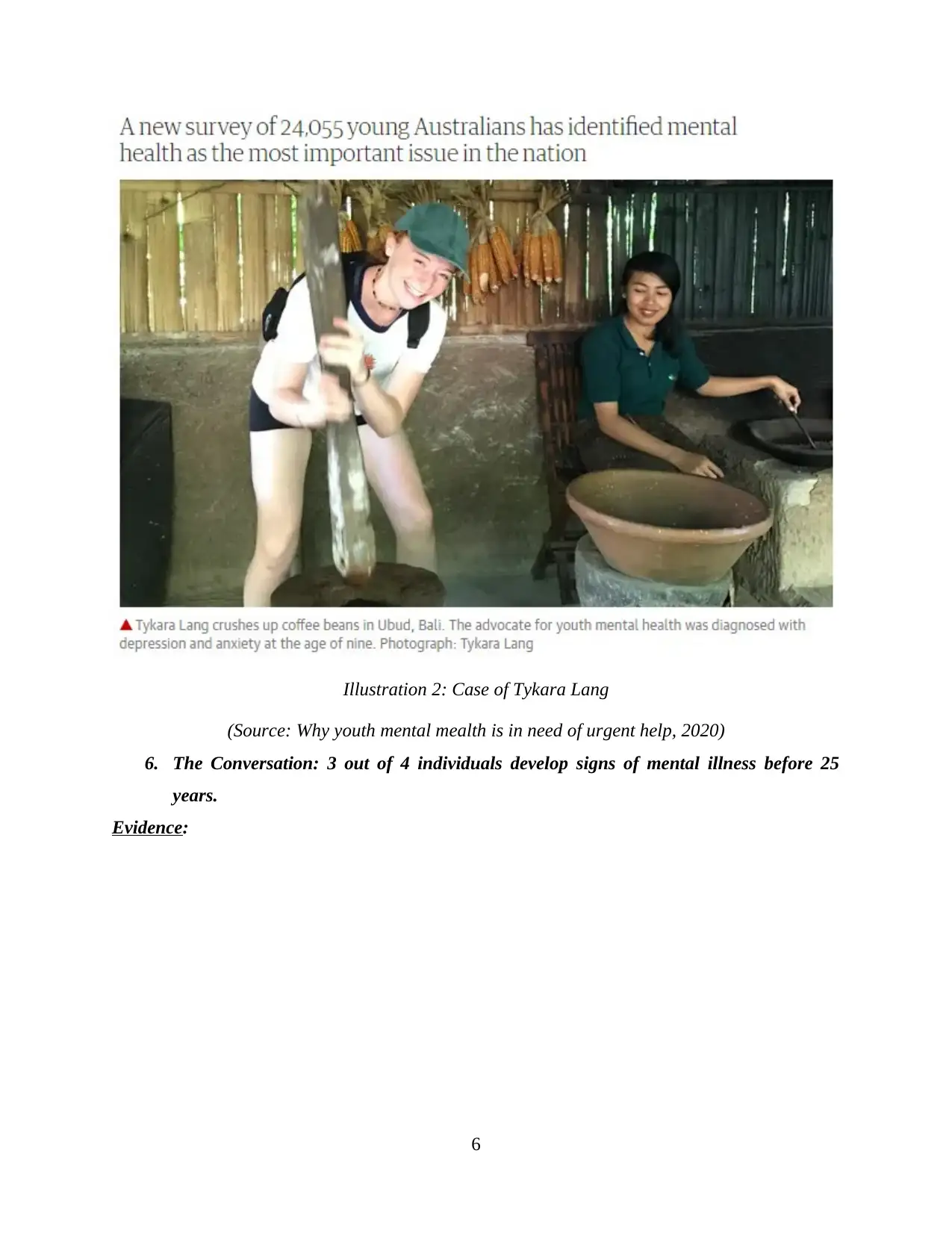
Illustration 2: Case of Tykara Lang
(Source: Why youth mental mealth is in need of urgent help, 2020)
6. The Conversation: 3 out of 4 individuals develop signs of mental illness before 25
years.
Evidence:
6
(Source: Why youth mental mealth is in need of urgent help, 2020)
6. The Conversation: 3 out of 4 individuals develop signs of mental illness before 25
years.
Evidence:
6
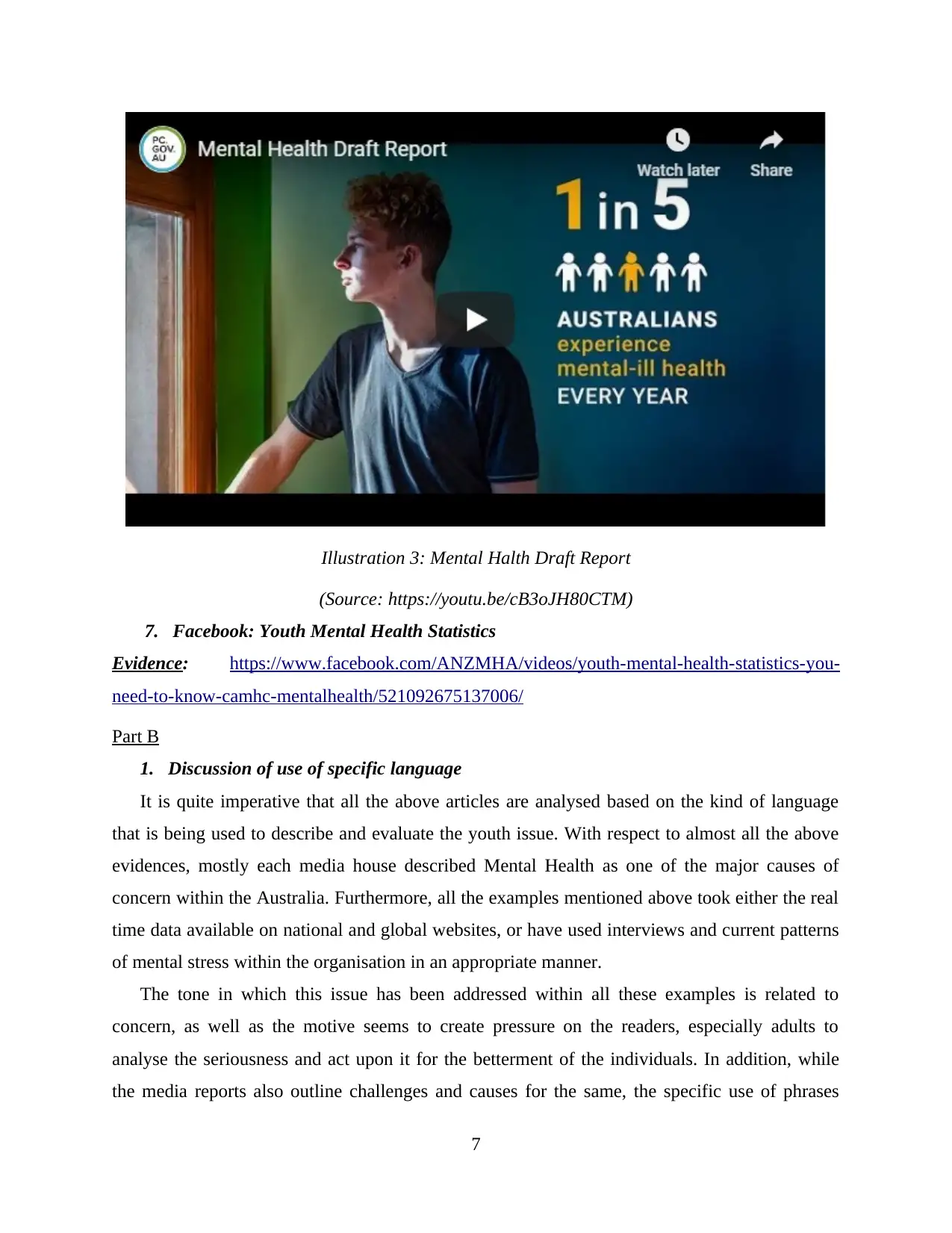
Illustration 3: Mental Halth Draft Report
(Source: https://youtu.be/cB3oJH80CTM)
7. Facebook: Youth Mental Health Statistics
Evidence: https://www.facebook.com/ANZMHA/videos/youth-mental-health-statistics-you-
need-to-know-camhc-mentalhealth/521092675137006/
Part B
1. Discussion of use of specific language
It is quite imperative that all the above articles are analysed based on the kind of language
that is being used to describe and evaluate the youth issue. With respect to almost all the above
evidences, mostly each media house described Mental Health as one of the major causes of
concern within the Australia. Furthermore, all the examples mentioned above took either the real
time data available on national and global websites, or have used interviews and current patterns
of mental stress within the organisation in an appropriate manner.
The tone in which this issue has been addressed within all these examples is related to
concern, as well as the motive seems to create pressure on the readers, especially adults to
analyse the seriousness and act upon it for the betterment of the individuals. In addition, while
the media reports also outline challenges and causes for the same, the specific use of phrases
7
(Source: https://youtu.be/cB3oJH80CTM)
7. Facebook: Youth Mental Health Statistics
Evidence: https://www.facebook.com/ANZMHA/videos/youth-mental-health-statistics-you-
need-to-know-camhc-mentalhealth/521092675137006/
Part B
1. Discussion of use of specific language
It is quite imperative that all the above articles are analysed based on the kind of language
that is being used to describe and evaluate the youth issue. With respect to almost all the above
evidences, mostly each media house described Mental Health as one of the major causes of
concern within the Australia. Furthermore, all the examples mentioned above took either the real
time data available on national and global websites, or have used interviews and current patterns
of mental stress within the organisation in an appropriate manner.
The tone in which this issue has been addressed within all these examples is related to
concern, as well as the motive seems to create pressure on the readers, especially adults to
analyse the seriousness and act upon it for the betterment of the individuals. In addition, while
the media reports also outline challenges and causes for the same, the specific use of phrases
7
⊘ This is a preview!⊘
Do you want full access?
Subscribe today to unlock all pages.

Trusted by 1+ million students worldwide
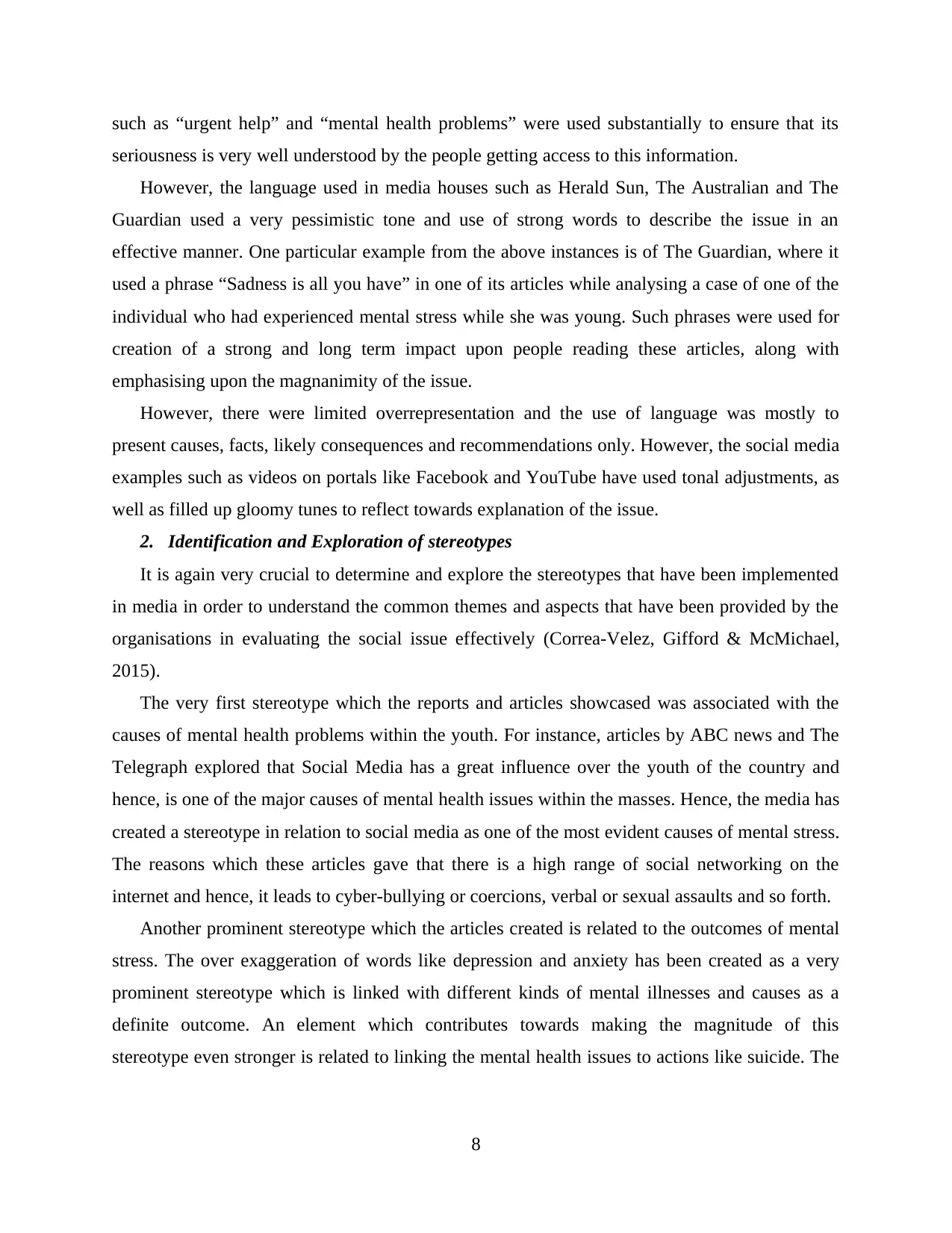
such as “urgent help” and “mental health problems” were used substantially to ensure that its
seriousness is very well understood by the people getting access to this information.
However, the language used in media houses such as Herald Sun, The Australian and The
Guardian used a very pessimistic tone and use of strong words to describe the issue in an
effective manner. One particular example from the above instances is of The Guardian, where it
used a phrase “Sadness is all you have” in one of its articles while analysing a case of one of the
individual who had experienced mental stress while she was young. Such phrases were used for
creation of a strong and long term impact upon people reading these articles, along with
emphasising upon the magnanimity of the issue.
However, there were limited overrepresentation and the use of language was mostly to
present causes, facts, likely consequences and recommendations only. However, the social media
examples such as videos on portals like Facebook and YouTube have used tonal adjustments, as
well as filled up gloomy tunes to reflect towards explanation of the issue.
2. Identification and Exploration of stereotypes
It is again very crucial to determine and explore the stereotypes that have been implemented
in media in order to understand the common themes and aspects that have been provided by the
organisations in evaluating the social issue effectively (Correa-Velez, Gifford & McMichael,
2015).
The very first stereotype which the reports and articles showcased was associated with the
causes of mental health problems within the youth. For instance, articles by ABC news and The
Telegraph explored that Social Media has a great influence over the youth of the country and
hence, is one of the major causes of mental health issues within the masses. Hence, the media has
created a stereotype in relation to social media as one of the most evident causes of mental stress.
The reasons which these articles gave that there is a high range of social networking on the
internet and hence, it leads to cyber-bullying or coercions, verbal or sexual assaults and so forth.
Another prominent stereotype which the articles created is related to the outcomes of mental
stress. The over exaggeration of words like depression and anxiety has been created as a very
prominent stereotype which is linked with different kinds of mental illnesses and causes as a
definite outcome. An element which contributes towards making the magnitude of this
stereotype even stronger is related to linking the mental health issues to actions like suicide. The
8
seriousness is very well understood by the people getting access to this information.
However, the language used in media houses such as Herald Sun, The Australian and The
Guardian used a very pessimistic tone and use of strong words to describe the issue in an
effective manner. One particular example from the above instances is of The Guardian, where it
used a phrase “Sadness is all you have” in one of its articles while analysing a case of one of the
individual who had experienced mental stress while she was young. Such phrases were used for
creation of a strong and long term impact upon people reading these articles, along with
emphasising upon the magnanimity of the issue.
However, there were limited overrepresentation and the use of language was mostly to
present causes, facts, likely consequences and recommendations only. However, the social media
examples such as videos on portals like Facebook and YouTube have used tonal adjustments, as
well as filled up gloomy tunes to reflect towards explanation of the issue.
2. Identification and Exploration of stereotypes
It is again very crucial to determine and explore the stereotypes that have been implemented
in media in order to understand the common themes and aspects that have been provided by the
organisations in evaluating the social issue effectively (Correa-Velez, Gifford & McMichael,
2015).
The very first stereotype which the reports and articles showcased was associated with the
causes of mental health problems within the youth. For instance, articles by ABC news and The
Telegraph explored that Social Media has a great influence over the youth of the country and
hence, is one of the major causes of mental health issues within the masses. Hence, the media has
created a stereotype in relation to social media as one of the most evident causes of mental stress.
The reasons which these articles gave that there is a high range of social networking on the
internet and hence, it leads to cyber-bullying or coercions, verbal or sexual assaults and so forth.
Another prominent stereotype which the articles created is related to the outcomes of mental
stress. The over exaggeration of words like depression and anxiety has been created as a very
prominent stereotype which is linked with different kinds of mental illnesses and causes as a
definite outcome. An element which contributes towards making the magnitude of this
stereotype even stronger is related to linking the mental health issues to actions like suicide. The
8
Paraphrase This Document
Need a fresh take? Get an instant paraphrase of this document with our AI Paraphraser
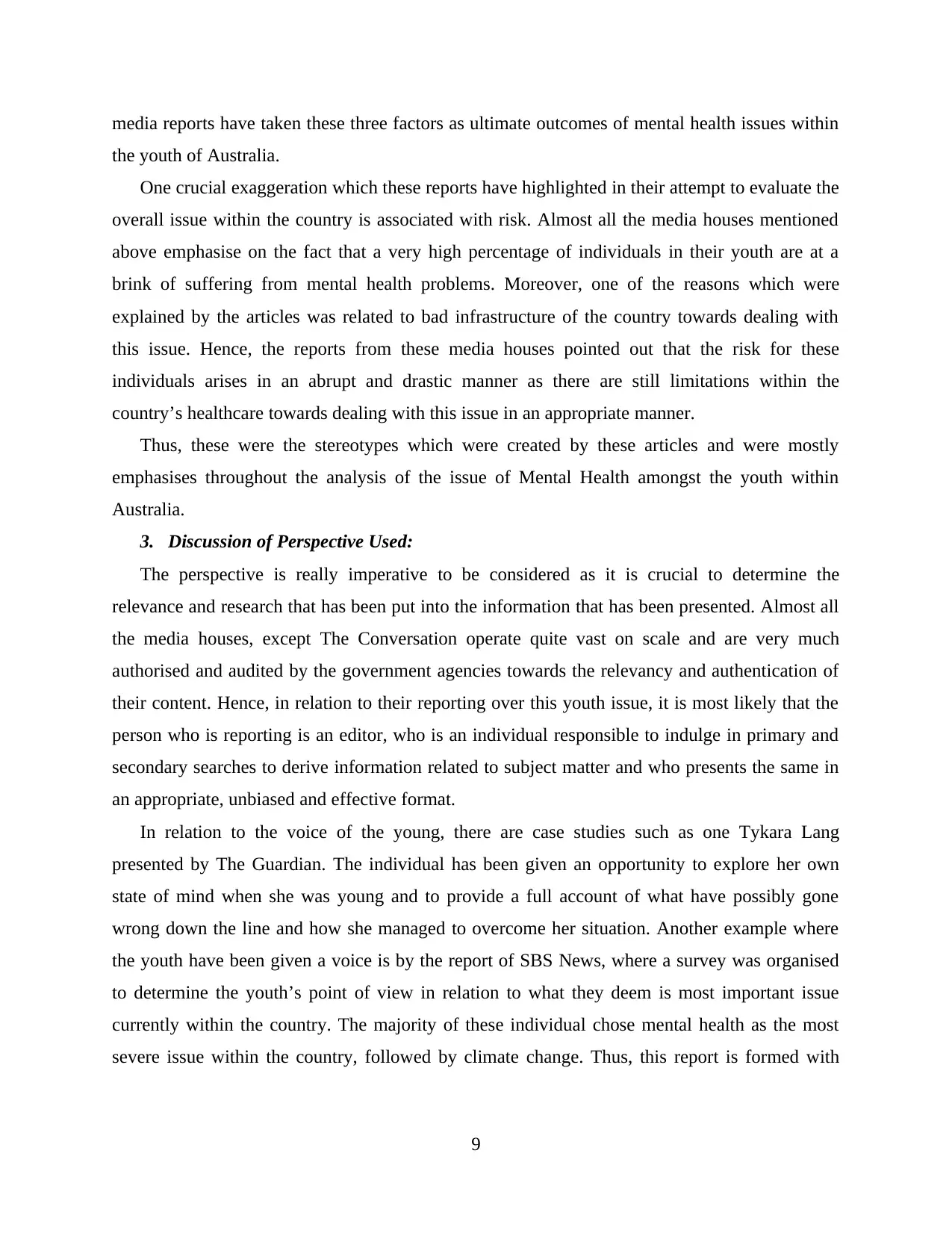
media reports have taken these three factors as ultimate outcomes of mental health issues within
the youth of Australia.
One crucial exaggeration which these reports have highlighted in their attempt to evaluate the
overall issue within the country is associated with risk. Almost all the media houses mentioned
above emphasise on the fact that a very high percentage of individuals in their youth are at a
brink of suffering from mental health problems. Moreover, one of the reasons which were
explained by the articles was related to bad infrastructure of the country towards dealing with
this issue. Hence, the reports from these media houses pointed out that the risk for these
individuals arises in an abrupt and drastic manner as there are still limitations within the
country’s healthcare towards dealing with this issue in an appropriate manner.
Thus, these were the stereotypes which were created by these articles and were mostly
emphasises throughout the analysis of the issue of Mental Health amongst the youth within
Australia.
3. Discussion of Perspective Used:
The perspective is really imperative to be considered as it is crucial to determine the
relevance and research that has been put into the information that has been presented. Almost all
the media houses, except The Conversation operate quite vast on scale and are very much
authorised and audited by the government agencies towards the relevancy and authentication of
their content. Hence, in relation to their reporting over this youth issue, it is most likely that the
person who is reporting is an editor, who is an individual responsible to indulge in primary and
secondary searches to derive information related to subject matter and who presents the same in
an appropriate, unbiased and effective format.
In relation to the voice of the young, there are case studies such as one Tykara Lang
presented by The Guardian. The individual has been given an opportunity to explore her own
state of mind when she was young and to provide a full account of what have possibly gone
wrong down the line and how she managed to overcome her situation. Another example where
the youth have been given a voice is by the report of SBS News, where a survey was organised
to determine the youth’s point of view in relation to what they deem is most important issue
currently within the country. The majority of these individual chose mental health as the most
severe issue within the country, followed by climate change. Thus, this report is formed with
9
the youth of Australia.
One crucial exaggeration which these reports have highlighted in their attempt to evaluate the
overall issue within the country is associated with risk. Almost all the media houses mentioned
above emphasise on the fact that a very high percentage of individuals in their youth are at a
brink of suffering from mental health problems. Moreover, one of the reasons which were
explained by the articles was related to bad infrastructure of the country towards dealing with
this issue. Hence, the reports from these media houses pointed out that the risk for these
individuals arises in an abrupt and drastic manner as there are still limitations within the
country’s healthcare towards dealing with this issue in an appropriate manner.
Thus, these were the stereotypes which were created by these articles and were mostly
emphasises throughout the analysis of the issue of Mental Health amongst the youth within
Australia.
3. Discussion of Perspective Used:
The perspective is really imperative to be considered as it is crucial to determine the
relevance and research that has been put into the information that has been presented. Almost all
the media houses, except The Conversation operate quite vast on scale and are very much
authorised and audited by the government agencies towards the relevancy and authentication of
their content. Hence, in relation to their reporting over this youth issue, it is most likely that the
person who is reporting is an editor, who is an individual responsible to indulge in primary and
secondary searches to derive information related to subject matter and who presents the same in
an appropriate, unbiased and effective format.
In relation to the voice of the young, there are case studies such as one Tykara Lang
presented by The Guardian. The individual has been given an opportunity to explore her own
state of mind when she was young and to provide a full account of what have possibly gone
wrong down the line and how she managed to overcome her situation. Another example where
the youth have been given a voice is by the report of SBS News, where a survey was organised
to determine the youth’s point of view in relation to what they deem is most important issue
currently within the country. The majority of these individual chose mental health as the most
severe issue within the country, followed by climate change. Thus, this report is formed with
9
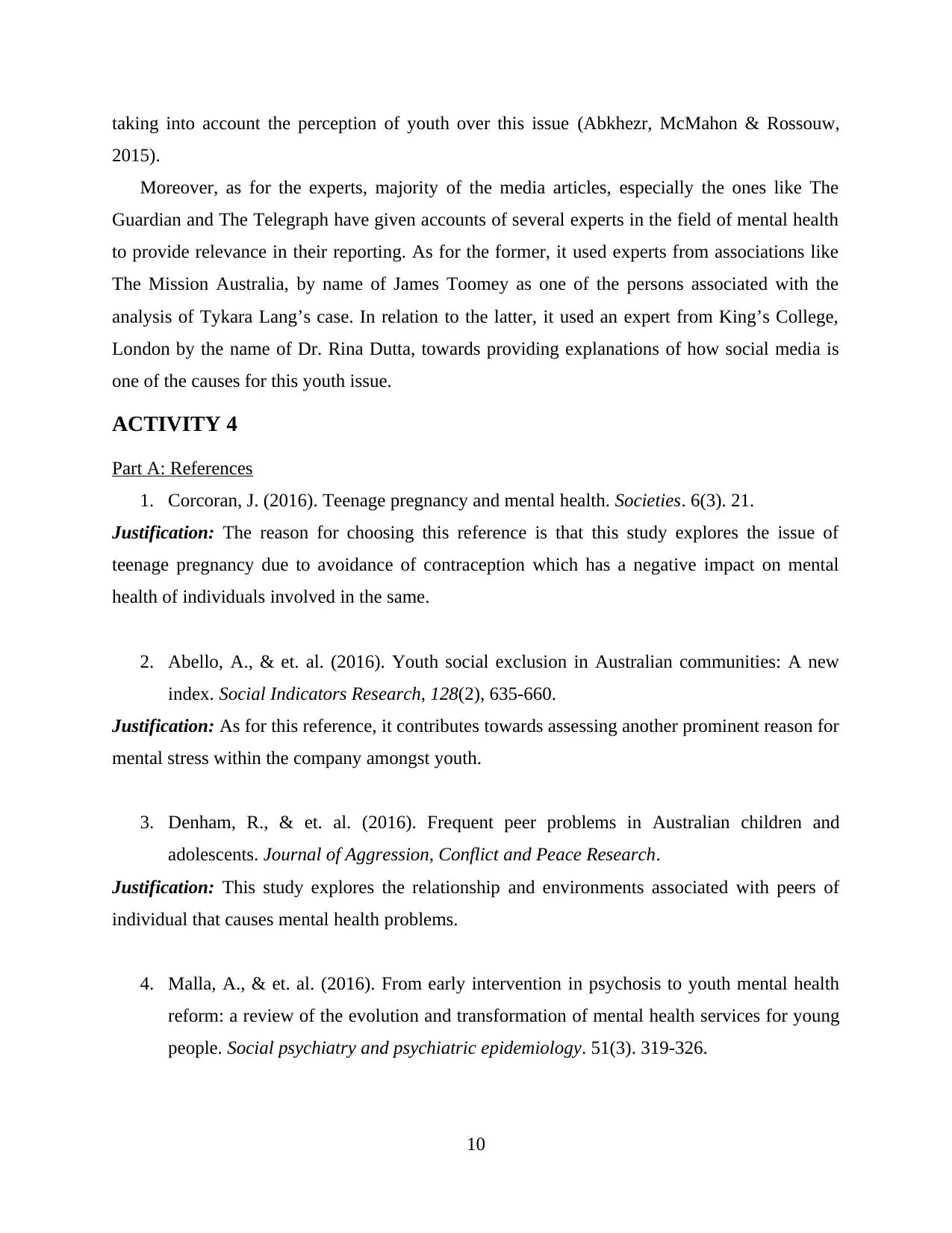
taking into account the perception of youth over this issue (Abkhezr, McMahon & Rossouw,
2015).
Moreover, as for the experts, majority of the media articles, especially the ones like The
Guardian and The Telegraph have given accounts of several experts in the field of mental health
to provide relevance in their reporting. As for the former, it used experts from associations like
The Mission Australia, by name of James Toomey as one of the persons associated with the
analysis of Tykara Lang’s case. In relation to the latter, it used an expert from King’s College,
London by the name of Dr. Rina Dutta, towards providing explanations of how social media is
one of the causes for this youth issue.
ACTIVITY 4
Part A: References
1. Corcoran, J. (2016). Teenage pregnancy and mental health. Societies. 6(3). 21.
Justification: The reason for choosing this reference is that this study explores the issue of
teenage pregnancy due to avoidance of contraception which has a negative impact on mental
health of individuals involved in the same.
2. Abello, A., & et. al. (2016). Youth social exclusion in Australian communities: A new
index. Social Indicators Research, 128(2), 635-660.
Justification: As for this reference, it contributes towards assessing another prominent reason for
mental stress within the company amongst youth.
3. Denham, R., & et. al. (2016). Frequent peer problems in Australian children and
adolescents. Journal of Aggression, Conflict and Peace Research.
Justification: This study explores the relationship and environments associated with peers of
individual that causes mental health problems.
4. Malla, A., & et. al. (2016). From early intervention in psychosis to youth mental health
reform: a review of the evolution and transformation of mental health services for young
people. Social psychiatry and psychiatric epidemiology. 51(3). 319-326.
10
2015).
Moreover, as for the experts, majority of the media articles, especially the ones like The
Guardian and The Telegraph have given accounts of several experts in the field of mental health
to provide relevance in their reporting. As for the former, it used experts from associations like
The Mission Australia, by name of James Toomey as one of the persons associated with the
analysis of Tykara Lang’s case. In relation to the latter, it used an expert from King’s College,
London by the name of Dr. Rina Dutta, towards providing explanations of how social media is
one of the causes for this youth issue.
ACTIVITY 4
Part A: References
1. Corcoran, J. (2016). Teenage pregnancy and mental health. Societies. 6(3). 21.
Justification: The reason for choosing this reference is that this study explores the issue of
teenage pregnancy due to avoidance of contraception which has a negative impact on mental
health of individuals involved in the same.
2. Abello, A., & et. al. (2016). Youth social exclusion in Australian communities: A new
index. Social Indicators Research, 128(2), 635-660.
Justification: As for this reference, it contributes towards assessing another prominent reason for
mental stress within the company amongst youth.
3. Denham, R., & et. al. (2016). Frequent peer problems in Australian children and
adolescents. Journal of Aggression, Conflict and Peace Research.
Justification: This study explores the relationship and environments associated with peers of
individual that causes mental health problems.
4. Malla, A., & et. al. (2016). From early intervention in psychosis to youth mental health
reform: a review of the evolution and transformation of mental health services for young
people. Social psychiatry and psychiatric epidemiology. 51(3). 319-326.
10
⊘ This is a preview!⊘
Do you want full access?
Subscribe today to unlock all pages.

Trusted by 1+ million students worldwide
1 out of 18
Related Documents
Your All-in-One AI-Powered Toolkit for Academic Success.
+13062052269
info@desklib.com
Available 24*7 on WhatsApp / Email
![[object Object]](/_next/static/media/star-bottom.7253800d.svg)
Unlock your academic potential
Copyright © 2020–2025 A2Z Services. All Rights Reserved. Developed and managed by ZUCOL.





